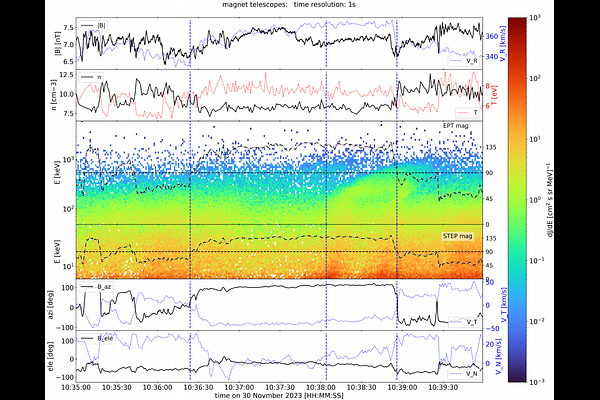A Tale of Two Shocks

A Tale of Two Shocks
Robert F. Wimmer-Schweingruber, Domenico Trotta, Rungployphan Kieokaew, Liu Yang, Alexander Kollhoff, Lars Berger, Patrick Kühl, Stephan I. Böttcher, Bernd Heber, Philippe Louarn, Andrey Fedorov, Javier Rodriguez-Pacheco, Raúl Gómez-Herrero, Francisco Espinosa Lara, Ignacio Cernuda, Yulia Kartavykh, Linghua Wang, George C. Ho, Robert C. Allen, Glenn M. Mason, Zheyi Ding, Andrea Larosa, G. Sindhuja, Sandra Eldrum, Sebastian Fleth, David Lario
AbstractIt was the best of times, it was the worst of times, . . . - for the thermal/suprathermal particle populations in the vicinity of two traveling interplanetary shocks observed by Solar Orbiter on 2023-11-29 07:51:17 UTC and 2023-11-30 10:47:26 UTC at $\sim 0.83$ astronomical units from the Sun. We investigate these two very dissimilar shocks and elucidate their non-equilibrium features. We do not provide explanations of all observed features, our aim is to report them here for future reference. We use high-resolution data obtained with Solar Orbiter's Energetic Particle Detector (EPD), magnetometer (MAG), and Solar Wind Analyzer (SWA) to exhibit the very different natures of these two shocks and describe the detailed properties of suprathermal and energetic particles in their vicinity. We observe very different behavior of the energetic particle population because the two shocks are quite different. Solar wind protons and $\alpha$-particles are highly dynamic at the first, their beams appear to align well with rapid oscillations of the interplanetary magnetic field. Suprathermal particles associated with the second shock exhibit clear non-equilibrium and anisotropic features in their differential intensities at time scales comparable to the proton gyroperiod. The different geometries of the two shocks resulted in highly dissimilar populations of suprathermal and energetic particles in their vicinity. The first shock was associated with very interesting microphysics of the bulk plasma velocity distribution, the second resulted in similarly interesting microphysics of the accelerated particles. Both showed strong temporal variability of the particle populations at scales comparable to the proton gyroperiod.